《儿科学》课程教学资源(授课教案)09 Haematopoiesis and Blood Cell Counts
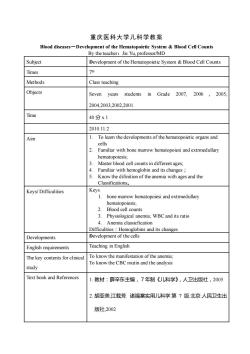
重庆医科大学儿科学教案Blood diseases-Development of the Hematopoietic System & Blood Cell CountsBy the teacher: Jie Yu, professor/MDSubjectDevelopment of theHematopoietic System &Blood CellCountsTimes7thMethodsClass teachingObjectsSeven yearsstudents in Grade 2007,2006, 2005,2004,2003,2002,2001Time40分x12010.11.2To learn the developments of the hematopoietic organs andAimcellsFamiliar with bone marrow hematopoiesi and extrmedullaryhematopoiesisMaster blood cell counts in different ages:Familiar with hemoglobin and its changes ;4.Know the difinition of the anemia with ages and theClassificationsKeysKeys/ Difficulitiesow hematopoiesi and extrmedullarybonemarrhematopoiesis;Blood cell counts2 Physiological anemia, WBC and its ratioAnemia classicficationDifficulities : Hemoglobins and its changesDevelopment of the cellsDevelopmentsTeaching in EnglishEnglish requirementsTo know the manifestation of the anemia,Thekey contents forclinicalTo know the CBC routin and the analysisstudyText book and References1.教材:薛辛东主编,7年制《儿科学》,人卫出版社,20052.胡亚美,江载芳.诸福棠实用儿科学.第7版.北京:人民卫生出版社,2002
重庆医科大学儿科学教案 Blood diseases-Development of the Hematopoietic System & Blood Cell Counts By the teacher:Jie Yu, professor/MD Subject Development of the Hematopoietic System & Blood Cell Counts Times 7 th Methods Class teaching Objects Seven years students in Grade 2007, 2006 , 2005, 2004,2003,2002,2001 Time 40 分 x 1 2010.11.2 Aim 1. To learn the developments of the hematopoietic organs and cells 2. Familiar with bone marrow hematopoiesi and extrmedullary hematopoiesis; 3. Master blood cell counts in different ages; 4. Familiar with hemoglobin and its changes; 5. Know the difinition of the anemia with ages and the Classifications。 Keys/ Difficulities Keys 1. bone marrow hematopoiesi and extrmedullary hematopoiesis; 2. Blood cell counts 3. Physiological anemia; WBC and its ratio 4. Anemia classicfication Difficulities:Hemoglobins and its changes Developments Development of the cells English requirements Teaching in English The key contents for clinical study To know the manifestation of the anemia; To know the CBC routin and the analysis Text book and References 1. 教材:薛辛东主编,7年制《儿科学》,人卫出版社,2005 2. 胡亚美,江载芳. 诸福棠实用儿科学.第 7 版.北京:人民卫生出 版社,2002
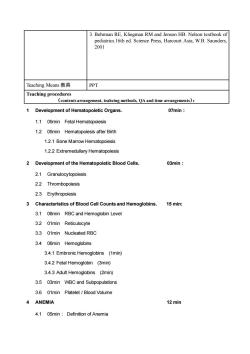
3BehrmanREKliegmanRMandJensonHBNelsontextbookofpediatrics.16th ed. Science Press, Harcourt Asia, W.B. Saunders,2001Teaching Means 教具PPTTeaching procedures(contents arrangement, teahcing methods, QA and time arrangements) :07min :1 Development of Hematopoietic Organs.1.1 05min Fetal Hematopoiesis1.2 05min Hematopoiesis after Birth1.2.1 Bone Marrow Hematopoiesis1.2.2 Extremedullary Hematopoiesis03min :2Development of the Hematopoietic Blood Cells.2.1 Granulocytopoiesis2.2Thrombopoiesis2.3 Erythropoiesis15min:3CharacteristicsofBloodCell CountsandHemoglobins.3.106min RBC and Hemoglobin Level3.2 01min Reticulocyte3.3 01min Nucleated RBC3.4 06min Hemoglobins3.4.1 Embronic Hemoglobins (1min)3.4.2 Fetal Hemoglobin (3min)3.4.3 Adult Hemoglobins (2min)3.5 03min WBC and Subpopulations3.6 01min Platelet /Blood Volume12 min4ANEMIA4.1 05min : Definition of Anemia
3. Behrman RE, Kliegman RM and Jenson HB. Nelson textbook of pediatrics.16th ed. Science Press, Harcourt Asia, W.B. Saunders, 2001 Teaching Means 教具 PPT Teaching procedures (contents arrangement, teahcing methods, QA and time arrangements): 1 Development of Hematopoietic Organs. 07min: 1.1 05min Fetal Hematopoiesis 1.2 05min Hematopoiesis after Birth 1.2.1 Bone Marrow Hematopoiesis 1.2.2 Extremedullary Hematopoiesis 2 Development of the Hematopoietic Blood Cells. 03min: 2.1 Granulocytopoiesis 2.2 Thrombopoiesis 2.3 Erythropoiesis 3 Characteristics of Blood Cell Counts and Hemoglobins. 15 min: 3.1 06min RBC and Hemoglobin Level 3.2 01min Reticulocyte 3.3 01min Nucleated RBC 3.4 06min Hemoglobins 3.4.1 Embronic Hemoglobins (1min) 3.4.2 Fetal Hemoglobin (3min) 3.4.3 Adult Hemoglobins (2min) 3.5 03min WBC and Subpopulations 3.6 01min Platelet / Blood Volume 4 ANEMIA 12 min 4.1 05min: Definition of Anemia
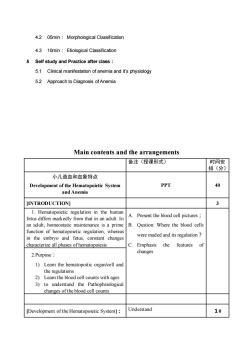
4.2 05min:Morphological Classification4.310min:EtiologicalClassification5Self studyandPracticeafter class5.1 Clinical manifestation of anemia and it's physiology5.2Approach to Diagnosis of AnemiaMain contents and the arrangements备注(授课形式)时间安排(分)小儿造血和血象特点PPT40 Development of the Hematopoietic Systemand Anemia[INTRODUCTION]31. Hematopoietic regulation in the human Present the blood cell pictures ;fetus differs markedly from that in an adult. Inan adult, homeostatic maintenance is a primeB.Qustion: Where the blood cellsfunction of hematopoietic regulation, whereaswere maded and its regulation ?in the embryo and fetus, constant changesofcharacterize all phases ofhematopoiesisEmphasisthefeatureschanges2.Purpose1) Learn the hematopoitic organ/cell andthe regulations2) Learn the blood cell counts with ages3) to understand the Pathophsiologicalchanges of the blood cell countsUnderstand10[Development of the Hematopoietic System] :
4.2 05min: Morphological Classification 4.3 10min: Etiological Classification 5 Self study and Practice after class : 5.1 Clinical manifestation of anemia and it’s physiology 5.2 Approach to Diagnosis of Anemia Main contents and the arrangements 备注(授课形式) 时间安 排(分) 小儿造血和血象特点 Development of the Hematopoietic System and Anemia PPT 40 [INTRODUCTION] 3 1. Hematopoietic regulation in the human fetus differs markedly from that in an adult. In an adult, homeostatic maintenance is a prime function of hematopoietic regulation, whereas in the embryo and fetus, constant changes characterize all phases of hematopoiesis A. Present the blood cell pictures; B. Qustion: Where the blood cells were maded and its regulation? C. Emphasis the features of changes 2.Purpose: 1) Learn the hematopoitic organ/cell and the regulations 2) Learn the blood cell counts with ages 3) to understand the Pathophsiological changes of the blood cell counts [Development of the Hematopoietic System]: Understand 10
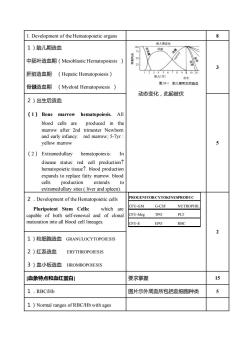
1. Development of the Hematopoietic organs1)胎儿期造血中胚叶造血期(MesoblasticHematopoiesis698911020肝脏造血期(HepaticHematopoiesis)胎儿928-1胎儿期和生后造血骨髓造血期(MyeloidHematopoiesis)动态变化,此起彼伏2)出生后造血(1) Bonemarrowhematopoiesis.Allproduced in thebloodcells aremarrow after 2nd trimester Newbornand early infancy: red marrow; 5-7yr :yellowmarrow5(2) Extramedullaryhematopoiesis:disease status: red cell production↑hematopoietictssueblood productionexpands to replace fatty marrow. bloodcellsproductionextendstoextramedullary sites (liverand spleen).PROGENITORCYTOKINESPRODUC2 . Development of the Hematopoietic cellsCFU-GMG-CSFNUTROPHILPluripotent Stem Cells:whichareFU-MegTPOPLTcapable of both self-renewal and of clonalmaturation into all blood cell lineagesCFU-EEPORBC21)粒细胞造血GRANULOCYTOPOIESIS2)红系造血ERYTHROPOIESIS3)血小板造血HROMBOPOIESIS15[血象特点和血红蛋白]要求掌握图片示外周血所包括血细胞种类1 . RBC/Hb51 ) Normal ranges of RBC/Hb with ages
1. Development of the Hematopoietic organs 8 1)胎儿期造血 中胚叶造血期(Mesoblastic Hematopoiesis ) 肝脏造血期 (Hepatic Hematopoiesis) 骨髓造血期 (Myeloid Hematopoiesis ) 动态变化,此起彼伏 3 2)出生后造血 (1) Bone marrow hematopoiesis. All blood cells are produced in the marrow after 2nd trimester Newborn and early infancy: red marrow; 5-7yr : yellow marrow (2) Extramedullary hematopoiesis: In disease status: red cell production hematopoietic tissue. blood production expands to replace fatty marrow. blood cells production extends to extramedullary sites ( liver and spleen). 5 2.Development of the Hematopoietic cells Pluripotent Stem Cells: which are capable of both self-renewal and of clonal maturation into all blood cell lineages. PROGENITORCYTOKINESPRODUC CFU-GM G-CSF NUTROPHIL CFU-Meg TPO PLT CFU-E BFU-E EPO RBC 2 1)粒细胞造血 GRANULOCYTOPOIESIS 2)红系造血 ERYTHROPOIESIS 3)血小板造血 HROMBOPOIESIS [血象特点和血红蛋白] 要求掌握 15 1.RBC/Hb 图片示外周血所包括血细胞种类 5 1)Normal ranges of RBC/Hb with ages
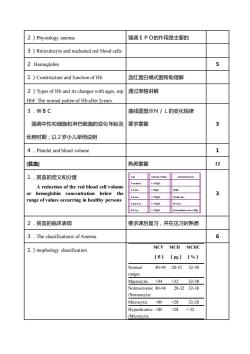
2 ) Physiology anemia强调 E P O的作用是主要的3 ) Reticulocyte and nucleated red blood cells2.Hemoglobin51 ) Constructure and function of Hb血红蛋白模式图帮助理解通过表格讲解2 ) Types of Hb and its changes with ages, esp1HbF. The normal patten of Hb after 2years3.WBC曲线图显示N / L的变化规律要求掌握3强调中性粒细胞和淋巴细胞的变化年龄及优势时期;以2岁小儿举例说明14 . Platelet and blood volume[贫血]12熟悉掌握1:贫血的定义和分度nemia Valueemia DegreNewbornAreductionoftheredbloodcellvolume90theorhemoglobinconcentration below3Modersrange of values occurring in healthy persons110/remelsevere:3232-38>04Normocromic80-9428-3232-38/NormocyticM32-28crocvHypochromic ≤8028<32/Microcyti
2)Physiology anemia 强调EPO的作用是主要的 3)Reticulocyte and nucleated red blood cells 2. Hemoglobin 5 1)Constructure and function of Hb 血红蛋白模式图帮助理解 2)Types of Hb and its changes with ages, esp HbF. The normal patten of Hb after 2years. 通过表格讲解 3.WBC 强调中性粒细胞和淋巴细胞的变化年龄及 优势时期;以2岁小儿举例说明 曲线图显示N/L的变化规律 要求掌握 3 4.Platelet and blood volume 1 [贫血] 熟悉掌握 12 1.贫血的定义和分度 A reduction of the red blood cell volume or hemoglobin concentration below the range of values occurring in healthy persons 3 2.贫血的临床表现 要求课后复习,并在见习时熟悉 3.The classifications of Anemia 6 1)mophology classification MCV (fl) MCH (pg) MCHC (%) Normal ranges 80-94 28-32 32-38 Macrocytic >94 >32 32-38 Normocromic /Normocytic 80-94 28-32 32-38 Microcytic <80 <28 32-28 Hypochromic /Microcytic <80 <28 < 32 Age Anemia Values Anemia Degree Newborn < 145g/L 1-4 mo < 90g/L Mild: 4-6 mo < 100g/L -Moderate: 90g/L 6 mo-6 yr < 110g/L -Severe: 60g/L 6-14 yr < 120g/L -Extremelysevere:<30g/ 30g/L L

2 ) Etiology clssification简单介绍并提及常见疾病名称。红细胞生成减低溶血性贫血设血性贫血0[结课]回顾课堂内容,说明重点要求掌握的内容,布置见习的内容和要求复习题:1)Why the infants have more apparent extramedullary hemtopoiesis than the adults under thsame condition 为什么婴幼儿较成人容易出现骨髓外造血2)Physiology anemia and its casuses?生理性贫血及其产生的原因?3)Thetypes of Hb and itschanges,血红蛋白的种类?出生前后HbF、HbA、HbA2的变化特点4)The normal patten of Hbafter2years.?2岁后血红蛋白的正常组成模式及比例5)The difinition of the age related anemia6)RBCindexforhypochromic/microcytic anemia?小细胞低色素性贫血的红细胞指数?总结及补充修正授课年级总结及修正补充内容备注01级1)在讲胎儿时期造血时增加动态图形象接受以后补充2)注意课堂调动学生的主动性能02级1)有意识增加设问,前后复习和联系,吸引了同学的注意力
2)Etiology classification 红细胞生成减低 溶血性贫血 设血性贫血 简单介绍并提及常见疾病名称。 [结课] 0 回顾课堂内容,说明重点要求掌握的内容, 布置见习的内容和要求 复习题: 1) Why the infants have more apparent extramedullary hemtopoiesis than the adults under the same condition 为什么婴幼儿较成人容易出现骨髓外造血 ? 2) Physiology anemia and its casuses? 生理性贫血及其产生的原因 ? 3) The types of Hb and its changes , 血红蛋白的种类 ? 出生前后 HbF 、 HbA 、 HbA2 的 变化特点 4) The normal patten of Hb after 2years.? 2岁后血红蛋白的正常组成模式及比例 5) The difinition of the age related anemia 6) RBC index for hypochromic/microcytic anemia? 小细胞低色素性贫血的红细胞指数? 总结及补充修正 授课年级 总结及修正补充内容 备注 01 级 1) 在讲胎儿时期造血时增加动态图形象接受 2) 注意课堂调动学生的主动性能 以后补充 02 级 1) 有意识增加设问,前后复习和联系,吸引了同学的注意力
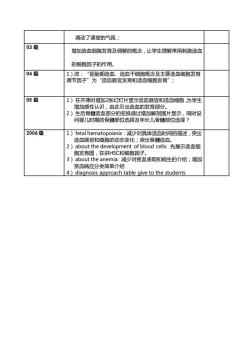
调动了课堂的气氛;03级增加造血细胞发育及调解的概念,让学生理解常用刺激造血的细胞因子的作用。04级1)改:“胚胎期造血、造血干细胞概念及主要造血细胞发育调节因子”为“造血器官发育和造血细胞发育”;05级1)在开课时增加2张幻灯片显示造血器官和造血细胞为学生增加感性认识,由此引出造血的发育部分。2)生后骨髓造血部分的变换通过增加解剖图片显示,同时设问婴儿时期的骨髓部位选择及年长儿骨髓部位选择?2006级1)fetalhematopoiesis:减少对具体造血时间的描述,突出造血器官和细胞的动态变化;突出骨髓造血。2) about the development of blood cells: 先展示造血细胞发育图,在讲HSC和细胞因子。3)about the anemia:减少对贫血表现和病生的介绍;增加贫血病应分类简单介绍4) diagnosis approach table give to the students
调动了课堂的气氛; 03 级 增加造血细胞发育及调解的概念,让学生理解常用刺激造血 的细胞因子的作用。 04 级 1)改:“胚胎期造血、造血干细胞概念及主要造血细胞发育 调节因子”为“造血器官发育和造血细胞发育”; 05 级 1) 在开课时增加2张幻灯片显示造血器官和造血细胞,为学生 增加感性认识,由此引出造血的发育部分。 2) 生后骨髓造血部分的变换通过增加解剖图片显示,同时设 问婴儿时期的骨髓部位选择及年长儿骨髓部位选择? 2006 级 1) fetal hematopoiesis:减少对具体造血时间的描述,突出 造血器官和细胞的动态变化;突出骨髓造血。 2) about the development of blood cells: 先展示造血细 胞发育图,在讲HSC和细胞因子。 3) about the anemia: 减少对贫血表现和病生的介绍;增加 贫血病应分类简单介绍 4) diagnosis approach table give to the students
按次数下载不扣除下载券;
注册用户24小时内重复下载只扣除一次;
顺序:VIP每日次数-->可用次数-->下载券;
- 《儿科学》课程教学资源(授课教案)08 Congenital Heart Disease.doc
- 《儿科学》课程教学资源(授课教案)06 Hypoxic-ischemic Encephalopathy.doc
- 《儿科学》课程教学资源(授课教案)07 Bronchopneumonia.doc
- 《儿科学》课程教学大纲 Teaching Outline for Pediatrics Course(英文).pdf
- 《临床生物化学》课程教学资源(PPT课件)第十九章 自动临床生物化学分析仪的应用及评价.ppt
- 《临床生物化学》课程教学资源(PPT课件)第十八章 治疗药物浓度监测.ppt
- 《临床生物化学》课程教学资源(PPT课件)第十七章 妊娠的生物化学检验.ppt
- 《临床生物化学》课程教学资源(PPT课件)第十六章 肿瘤标志物的生物化学检验.ppt
- 《临床生物化学》课程教学资源(PPT课件)第十五章 神经系统疾病的生物化学检验.ppt
- 《临床生物化学》课程教学资源(PPT课件)第十四章 消化系统疾病的生物化学检验.ppt
- 《临床生物化学》课程教学资源(PPT课件)第十三章 内分泌疾病的生物化学检测.ppt
- 《临床生物化学》课程教学资源(PPT课件)第十二章 心血管系统疾病的生物化学检测.ppt
- 《临床生物化学》课程教学资源(PPT课件)第十一章 肾功能损伤的生物化学检验.ppt
- 《临床生物化学》课程教学资源(PPT课件)第十章 肝胆疾病的生物化学检验.ppt
- 《临床生物化学》课程教学资源(PPT课件)第九章 营养状况的评估及的生物化学监测.ppt
- 《临床生物化学》课程教学资源(PPT课件)第八章 微量元素与维生素异常的生物化学检验.ppt
- 《临床生物化学》课程教学资源(PPT课件)第七章 骨代谢紊乱及相关元素的生物化学检验.ppt
- 《临床生物化学》课程教学资源(PPT课件)第六章 电解质和酸碱平衡紊乱的生物化学检验.ppt
- 《临床生物化学》课程教学资源(PPT课件)第五章 血浆脂蛋白代谢紊乱的生物化学检验.ppt
- 《临床生物化学》课程教学资源(PPT课件)第四章 糖代谢紊乱的生物化学检验.ppt
- 《儿科学》课程教学资源(授课教案)03 Nutrition During Childhood.doc
- 《儿科学》课程教学资源(授课教案)02 Growth and Development.doc
- 《儿科学》课程教学资源(授课教案)05 Neonatal Septicemia.doc
- 《儿科学》课程教学资源(授课教案)04 Neonatal Jaundice.doc
- 《儿科学》课程教学资源(授课教案)01 Introduction of Pediatrics.doc
- 《儿科学》课程教学资源(授课教案)25 Scarlet Fever.doc
- 《儿科学》课程教学资源(授课教案)23 Infantile Hepatitis Syndrome.doc
- 《儿科学》课程教学资源(授课教案)22 Infantale Diarrhea and Fluid Therapy.doc
- 《儿科学》课程教学资源(授课教案)24 Mumps.doc
- 《儿科学》课程教学资源(授课教案)18 Primary Pulmonary Tuberculosis.doc
- 《儿科学》课程教学资源(授课教案)21 Chronic Gastritis in Children.doc
- 《儿科学》课程教学资源(授课教案)20 Toxic Bacillary Dysentery.doc
- 《儿科学》课程教学资源(授课教案)19 Tuberculosis Meningitis.doc
- 《儿科学》课程教学资源(授课教案)16 Measles.doc
- 《儿科学》课程教学资源(授课教案)17 Varicella.doc
- 《儿科学》课程教学资源(授课教案)14 Congenital Hypothyroidism.doc
- 《儿科学》课程教学资源(授课教案)15 Growth Hormone Deficiency.doc
- 《儿科学》课程教学资源(授课教案)10 Nutritional Iron Deficiency Anemia.doc
- 《儿科学》课程教学资源(授课教案)13 Immunodeficiency.doc
- 《儿科学》课程教学资源(授课教案)11 Acute Convulsion in Children.doc
